ALevel数学2PPT课件
- 格式:ppt
- 大小:4.04 MB
- 文档页数:26

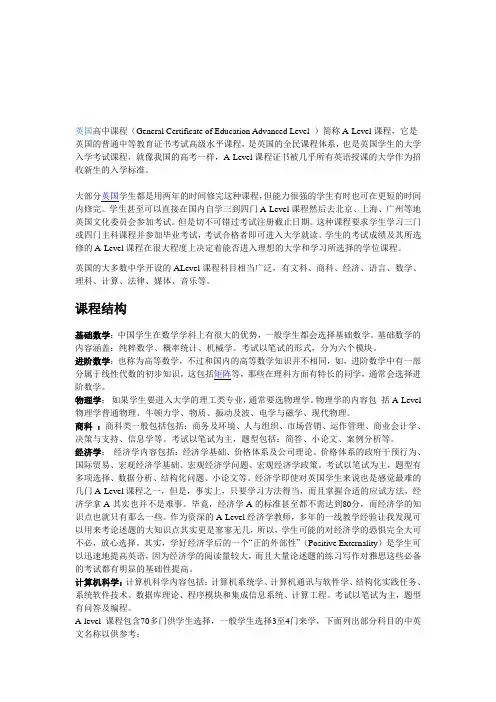
英国高中课程(General Certificate of Education Advanced Level )简称A-Level课程,它是英国的普通中等教育证书考试高级水平课程,是英国的全民课程体系,也是英国学生的大学入学考试课程,就像我国的高考一样,A-Level课程证书被几乎所有英语授课的大学作为招收新生的入学标准。
大部分英国学生都是用两年的时间修完这种课程,但能力很强的学生有时也可在更短的时间内修完。
学生甚至可以直接在国内自学三到四门A-Level课程然后去北京、上海、广州等地英国文化委员会参加考试。
但是切不可错过考试注册截止日期。
这种课程要求学生学习三门或四门主科课程并参加毕业考试,考试合格者即可进入大学就读。
学生的考试成绩及其所选修的A-Level课程在很大程度上决定着能否进入理想的大学和学习所选择的学位课程。
英国的大多数中学开设的ALevel课程科目相当广泛,有文科、商科、经济、语言、数学、理科、计算、法律、媒体、音乐等。
课程结构基础数学:中国学生在数学学科上有很大的优势,一般学生都会选择基础数学。
基础数学的内容涵盖:纯粹数学、概率统计、机械学。
考试以笔试的形式,分为六个模块。
进阶数学:也称为高等数学,不过和国内的高等数学知识并不相同,如,进阶数学中有一部分属于线性代数的初步知识,这包括矩阵等,那些在理科方面有特长的同学,通常会选择进阶数学。
物理学:如果学生要进入大学的理工类专业,通常要选物理学。
物理学的内容包括A-Level 物理学普通物理、牛顿力学、物质、振动及波、电学与磁学、现代物理。
商科:商科类一般包括包括:商务及环境、人与组织、市场营销、运作管理、商业会计学、决策与支持、信息学等。
考试以笔试为主,题型包括:简答、小论文、案例分析等。
经济学:经济学内容包括:经济学基础、价格体系及公司理论、价格体系的政府干预行为、国际贸易、宏观经济学基础、宏观经济学问题、宏观经济学政策。
考试以笔试为主,题型有多项选择、数据分析、结构化问题、小论文等。

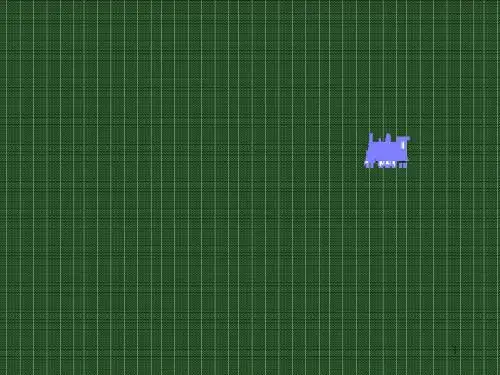
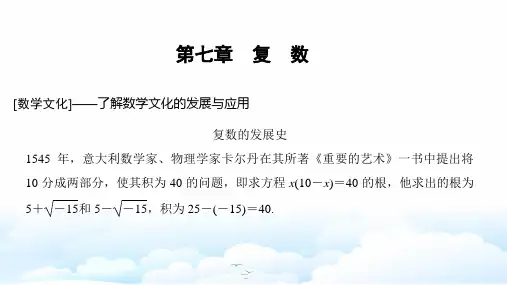
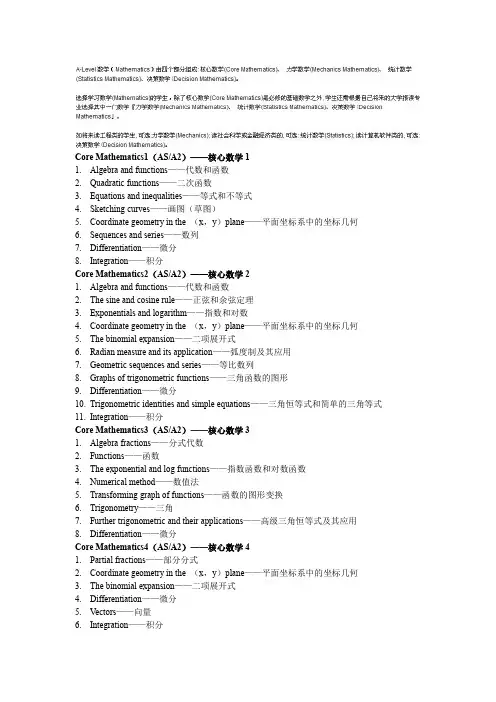
Core Mathematics1(AS/A2)——核心数学11.Algebra and functions——代数和函数2.Quadratic functions——二次函数3.Equations and inequalities——等式和不等式4.Sketching curves——画图(草图)5.Coordinate geometry in the (x,y)plane——平面坐标系中的坐标几何6.Sequences and series——数列7.Differentiation——微分8.Integration——积分Core Mathematics2(AS/A2)——核心数学21.Algebra and functions——代数和函数2.The sine and cosine rule——正弦和余弦定理3.Exponentials and logarithm——指数和对数4.Coordinate geometry in the (x,y)plane——平面坐标系中的坐标几何5.The binomial expansion——二项展开式6.Radian measure and its application——弧度制及其应用7.Geometric sequences and series——等比数列8.Graphs of trigonometric functions——三角函数的图形9.Differentiation——微分10.Trigonometric identities and simple equations——三角恒等式和简单的三角等式11.Integration——积分Core Mathematics3(AS/A2)——核心数学31.Algebra fractions——分式代数2.Functions——函数3.The exponential and log functions——指数函数和对数函数4.Numerical method——数值法5.Transforming graph of functions——函数的图形变换6.Trigonometry——三角7.Further trigonometric and their applications——高级三角恒等式及其应用8.Differentiation——微分Core Mathematics4(AS/A2)——核心数学41.Partial fractions——部分分式2.Coordinate geometry in the (x,y)plane——平面坐标系中的坐标几何3.The binomial expansion——二项展开式4.Differentiation——微分5.Vectors——向量6.Integration——积分A-Level:核心数学Core Maths,力学数学,统计数学,决策数学Core Mathematics1(AS/A2)——核心数学11.Algebra and functions——代数和函数2.Quadratic functions——二次函数3.Equations and inequalities——等式和不等式4.Sketching curves——画图(草图)5.Coordinate geometry in the (x,y)plane——平面坐标系中的坐标几何6.Sequences and series——数列7.Differentiation——微分8.Integration——积分每章内容:Core Mathematics2(AS/A2)——核心数学21.Algebra and functions——代数和函数2.The sine and cosine rule——正弦和余弦定理3.Exponentials and logarithm——指数和对数4.Coordinate geometry in the (x,y)plane——平面坐标系中的坐标几何5.The binomial expansion——二项展开式6.Radian measure and its application——弧度制及其应用7.Geometric sequences and series——等比数列8.Graphs of trigonometric functions——三角函数的图形9.Differentiation——微分10.Trigonometric identities and simple equations——三角恒等式和简单的三角等式11.Integration——积分每章内容:1.Algebra fractions——分式代数2.Functions——函数3.The exponential and log functions——指数函数和对数函数4.Numerical method——数值法5.Transforming graph of functions——函数的图形变换6.Trigonometry——三角7.Further trigonometric and their applications——高级三角恒等式及其应用8.Differentiation——微分每章内容:1.Partial fractions——部分分式2.Coordinate geometry in the (x,y)plane——平面坐标系中的坐标几何3.The binomial expansion——二项展开式4.Differentiation——微分5.Vectors——向量6.Integration——积分每章内容:。


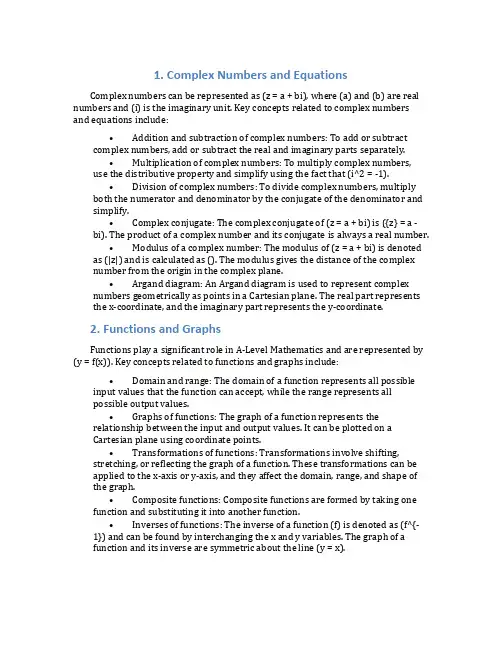
1. Complex Numbers and EquationsComplex numbers can be represented as (z = a + bi), where (a) and (b) are real numbers and (i) is the imaginary unit. Key concepts related to complex numbers and equations include:•Addition and subtraction of complex numbers: To add or subtract complex numbers, add or subtract the real and imaginary parts separately.•Multiplication of complex numbers: To multiply complex numbers, use the distributive property and simplify using the fact that (i^2 = -1).•Division of complex numbers: To divide complex numbers, multiply both the numerator and denominator by the conjugate of the denominator and simplify.•Complex conjugate: The complex conjugate of (z = a + bi) is ({z} = a - bi). The product of a complex number and its conjugate is always a real number.•Modulus of a complex number: The modulus of (z = a + bi) is denoted as (|z|) and is calculated as (). The modulus gives the distance of the complex number from the origin in the complex plane.•Argand diagram: An Argand diagram is used to represent complex numbers geometrically as points in a Cartesian plane. The real part represents the x-coordinate, and the imaginary part represents the y-coordinate.2. Functions and GraphsFunctions play a significant role in A-Level Mathematics and are represented by (y = f(x)). Key concepts related to functions and graphs include:•Domain and range: The domain of a function represents all possible input values that the function can accept, while the range represents allpossible output values.•Graphs of functions: The graph of a function represents the relationship between the input and output values. It can be plotted on aCartesian plane using coordinate points.•Transformations of functions: Transformations involve shifting, stretching, or reflecting the graph of a function. These transformations can be applied to the x-axis or y-axis, and they affect the domain, range, and shape of the graph.•Composite functions: Composite functions are formed by taking one function and substituting it into another function.•Inverses of functions: The inverse of a function (f) is denoted as (f^{-1}) and can be found by interchanging the x and y variables. The graph of afunction and its inverse are symmetric about the line (y = x).3. CalculusCalculus involves the study of differentiation and integration. Key concepts related to calculus include:•Differentiation: Differentiation allows us to find the rate of change of a function at a specific point. The derivative of a function (f(x)) with respect to (x) is denoted as () or (f’(x)).•Rules of differentiation: Differentiation rules include the power rule, product rule, quotient rule, and chain rule. These rules help us differentiatefunctions of various forms.•Maxima and minima: The derivative helps us identify the points of maximum and minimum on a graph. A point where the derivative equals zero or does not exist can indicate a local maximum or minimum.•Integration: Integration helps us find the area under the curve of a function. The integral of a function (f(x)) with respect to (x) is denoted as (f(x) dx).•Definite and indefinite integrals: A definite integral has limits of integration, while an indefinite integral represents a family of functions.•Fundamental theorem of calculus: The fundamental theorem of calculus relates integration and differentiation. It states that if (F(x)) is theantiderivative of (f(x)), then (_a^b f(x) dx = F(b) - F(a)).4. VectorsVectors have both magnitude and direction and are denoted as (). Key concepts related to vectors include:•Vector notation and representation: Vectors can be represented geometrically as directed line segments or algebraically using component form or column form.•Addition and subtraction of vectors: Vector addition and subtraction involve adding or subtracting the corresponding components of vectors.•Scalar multiplication: Scalar multiplication involves multiplying a vector by a scalar (real number).•Unit vectors: Unit vectors have a magnitude of 1 and are used to define the direction of a vector.•Dot product: The dot product of two vectors (a) and (b) is calculated as (a b = |a| |b| ), where () is the angle between the vectors.•Cross product: The cross product of two vectors (a) and (b) is denoted as (a b) and is a vector perpendicular to both (a) and (b). Its magnitude iscalculated as (|a b| = |a| |b| ).These are just some of the key knowledge points related to A-Level Mathematics Paper 2. Understanding and applying these concepts will greatly help in solving a variety of mathematical problems.。

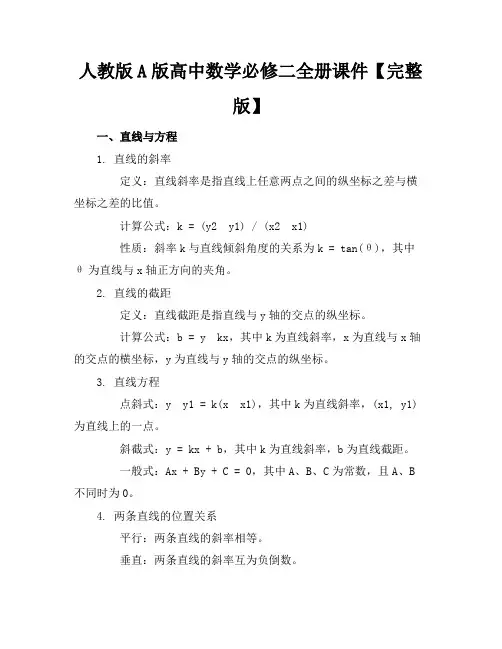
人教版A版高中数学必修二全册课件【完整版】一、直线与方程1. 直线的斜率定义:直线斜率是指直线上任意两点之间的纵坐标之差与横坐标之差的比值。
计算公式:k = (y2 y1) / (x2 x1)性质:斜率k与直线倾斜角度的关系为k = tan(θ),其中θ为直线与x轴正方向的夹角。
2. 直线的截距定义:直线截距是指直线与y轴的交点的纵坐标。
计算公式:b = y kx,其中k为直线斜率,x为直线与x轴的交点的横坐标,y为直线与y轴的交点的纵坐标。
3. 直线方程点斜式:y y1 = k(x x1),其中k为直线斜率,(x1, y1)为直线上的一点。
斜截式:y = kx + b,其中k为直线斜率,b为直线截距。
一般式:Ax + By + C = 0,其中A、B、C为常数,且A、B 不同时为0。
4. 两条直线的位置关系平行:两条直线的斜率相等。
垂直:两条直线的斜率互为负倒数。
相交:两条直线的斜率不相等。
二、圆与方程1. 圆的定义定义:圆是平面上所有与一个固定点(圆心)距离相等的点的集合。
2. 圆的标准方程方程:(x a)² + (y b)² = r²,其中(a, b)为圆心坐标,r 为半径。
3. 圆的一般方程方程:x² + y² + Dx + Ey + F = 0,其中D、E、F为常数。
4. 圆与直线的位置关系相离:直线与圆没有交点。
相切:直线与圆有且仅有一个交点。
相交:直线与圆有两个交点。
三、椭圆与方程1. 椭圆的定义定义:椭圆是平面上所有与两个固定点(焦点)距离之和等于常数的点的集合。
2. 椭圆的标准方程方程:(x h)²/a² + (y k)²/b² = 1,其中(h, k)为椭圆中心坐标,a为椭圆长轴的一半,b为椭圆短轴的一半。
3. 椭圆的一般方程方程:Ax² + By² + Cx + Dy + E = 0,其中A、B、C、D、E 为常数,且A、B不同时为0。